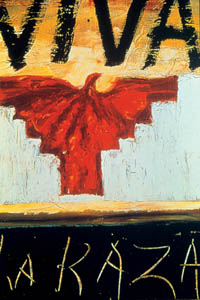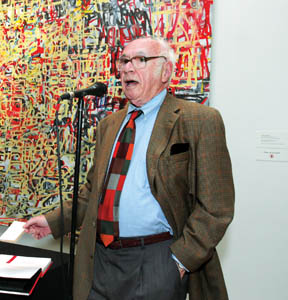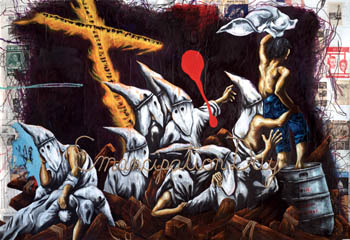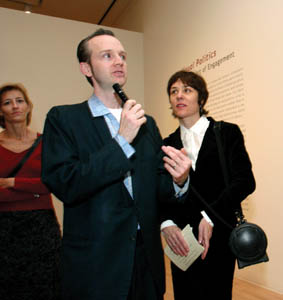![[Metroactive Arts]](/arts/gifs/art468.gif)
[ Arts Index | Silicon Valley | Metroactive Home | Archives ]
No Blood For Oils
Can good art change the world? The San Jose Museum of Art's new exhibit on visual politics shows that California artists in particular have a rich tradition of fighting the power.
By Richard von Busack
WHAT BETTER place to start a discussion of politically engaged art than with a series of images from Mad's maddest artist, Don Martin. A sculptor—smocked, bearded, beret'd, with the usual Martin-style pancake feet and crossed eyes—contemplates a tall block of marble. Staring, staring, staring. Finally, the chisel flashes. An insignificant little chip from one corner is knocked free. A good day's work done.
In comes the patron. "What do you call it?" he gasps.
Says the sculptor, rapt with his creation, "I call it Man's Inhumanity to Man!"
"What else could you call it? I'll take it!" And he stoops to pick up the little insignificant chip he's just purchased.
Like many philistine legends of modern art, Martin's story has several angles: the patron is too blind to tell the debris from the art; the modern artist as charlatan.
But there is a different angle on the joke: for an artist, there is something even easier than chipping once and calling it a day. And that something is reaching for easy, cheap political meaning: to take an abstraction and brand it with a lofty title like Man's Inhumanity to Man.
The War on Canvas
Some two score paintings, photographs, mixed-media pieces and sculptures are included at the San Jose Museum of Art's "Visual Politics: The Art of Engagement," a show that digs deep into the dilemmas facing any artist who strives to take a stand.
The museum's chief curator, Susan Landauer, wrote the introductory essay to the extensive book-size catalog, Peter Selz's Art of Engagement: Visual Politics in California Art and Beyond. She mentions the usual well-known political artists: "Käthe Kollwitz's haunting pleas for the working-class, Pablo Picasso's brutal antiwar protests and George Grosz's venomous satire appear to stand firm within the canon of modern art. Yet there has often been an ambivalence about mixing art and politics, even in periods of tremendous turmoil."
The elevator doors used to open on to Picasso's Guernica at its old location in the Museum of Modern Art in New York. The art rays—the immeasurable force of a work of art—were literally powerful enough to freeze you in your place, as the doors parted, revealing ever more. Are the art rays inherent in Guernica important? Or is it the painting's content? (Picasso was responding to the Fascists' bombing of the Spanish city.)
What good is art that carries a message? Art is impotent, isn't it? Art critic Harold Rosenberg, writing for The New Yorker in 1967, thought so: Guernica was of "doubtful political consequence," in that it failed to halt or embarrass the Nazis. It's "like taking a broomstick against a tank." His rival critic, Clement Greenberg, concurred. Art must "confine itself exclusively to what is given in visual experience."
In Rosenberg's and Greenberg's view of history, political art was a 1930s episode, surpassed by the explorations of Abstract Expressionism. The communist strain in political art was something that postwar artists had to outgrow. Greenberg wrote that "anti-Stalinism ... turned into art for art's sake, and cleared the way, heroically, for what was to come." What was to come, wrote critic Daniel Lazare, was "formalism at its most hermetic, a theory that held that art could succeed as art only if left undisturbed in its own separate realm." Art about art. (And, in the fullness of time, art about art about art.)
In the late 1960s and early '70s, when political anger started to re-emerge in popular art, some critics, such Hilton Kramer, worried that political art was the last stand of the old-line communists. There were also genuinely apolitical artists, who worried that political themes ignored the deeper water art was meant to divine—those hidden depths far below the everyday tempest. But California's own enthusiasm for using art as a weapon continued after the 1930s, despite the warnings from back East. As Landauer puts it, mixing art and politics may be one of California's most significant contributions to the world of art.
San Francisco Is Burning
In examining art that strives to serve a purpose—and in protesting that it can serve one—"Visual Politics" is an urgent show. Although it was five years in the making, it seems to have arrived right
on time.
The oldest paintings in the show can be seen in the museum's entryway: a pair of 1944 watercolors by the longshoreman/artist Erle Loran. San Francisco Burning I and San Francisco Burning II are a pair of pastel-colored washes in which softly delineated bombers rain fire on San Francisco. While the terrible vision is more than 60 years old, Bill O'Reilly's recent bon mot about letting Al Qaeda have a free show at Coit Tower gives the works a whole new meaning.
California's range of social, cultural and political opportunities provided a rich climate for engaged artists. In Southern California, the booming entertainment industry created much disposable income and lots of bare walls. Later, in Northern California, the Internet boom and millionaire vintners created a whole new class of patrons.
As Landauer writes, antagonism ignites an avant-garde. California served as the staging area for the Vietnam War and as the home of a multibillion-dollar defense industry. It was also a major battlefront in the anti-Vietnam War movement.
Then as now, the state was cracked with cultural fault lines. New residents arrived from the South and the East. Sexual ghettos formed in West Hollywood and San Francisco. And the ecology movement exploded as the bulldozing, drilling and clear-cutting of the state gave artists a compelling topic. California, the cuckoo's nest that hatched Reagan and Nixon was also the place where left-wing opposition to them started early.
The desultory Bay Area art fan might have run across Enrique Chagoya's Their Freedom of Expression ... The Recovery of Their Economy before. This 1984 charcoal and pastel drawing presents a likeness of California's own Ronald Reagan as a wrinkled, titanic Mickey Mouse; at his knee is a dwarf Mickey, with a face like Henry Kissinger's, scrawling on the wall, "By the way, keep art out of politi ..."
Angles of Riposte
The many angles of attack used by artists to address political themes include Masami Teraoka's 2002/2003 large-scale oil Semana Santa/Cloning Eve and Geisha, a hybrid of gilded church art and Japanese panels that comments on religious persecution, gender identity and the ambiguous promises of high tech.
The superb Hung Liu has two canvases in the show. Her 1988 Resident Alien is a gigantic replica of the identity card she received when she came to America from China. With acidic playfulness, she claims that her name translates to "Cookie, Fortune."
Hung's solo show, "Strange Fruit," which came through Sacramento and Laguna Beach three years ago, was worth seeing in both cities. There, she dealt with the cruelty of Chinese history and her own experiences in Mao's Cultural Revolution. She has taken the suffering she knew and turned it into canvases that seem both clear-eyed and tear-washed.
In Father and Son, the Vietnamese artist Dinh Q. Lê prints photographs on linen, cuts them into narrow strips and weaves them together, irrevocably meshing images from the film Apocalypse Now with found photographs of Vietnamese civilians. The work ties American images of a remote war to the grounded reality of the people who bore the brunt of the destruction.
In a frontal attack on American racism, Travis Somerville's bold Raft of the Grand Wizard references a firmly codified classic, Gericault's Raft of the Medusa. This raft is manned by hooded Ku Klux Klan members and topped by a mast in the form of a burning cross. (The dramatic original is reproduced on the cover of the Pogues' Rum, Sodomy and the Lash album.) As UCSC art professor Jasper Rose used to say of the Gericault, "Here was the Jaws of its day."
Appropriately, artists concerned with environmental issues use landscapes as their vehicle. Santa Cruz artists Helen and Newton Harrison's depict the clear-cutting of America's own rain forests in Serpentine Lattice, a series of projected images.
Paradoxically, Chester Arnold's rendering of the latticing left over from copper-mine excavations, with their ponds of tailing-filled water, is as turquoise blue as the most welcoming motel swimming pool at dusk. The terracing is as aesthetically pleasing as the ridges on the roof of New York's Guggenheim Museum—as long as you don't think of what this scar in the earth represents.
M. Louise Stanley is an endearingly witty Emeryville artist, a painter of Matissean cheer. She loves to rewrite classical myth. When she paints harpies, they're not only birds of prey but catty, thick-as-thieves pals. In the name of a whimsical feminism, Stanley reclaims Judgment of Paris by putting herself in as a candidate, peeking around a canvas to catch the eye of a bearded judge. The canvas echoes the Gorilla Girls' complaint that a woman has to be naked to get herself in a museum.
The Roots of Rebellion
"Visual Politics" contains work in a number of traditions. But it seems that many California artists developed the courage to use art as a weapon because of the strong tradition of Hispanic political and liturgical art.
The Mexican tradition of storytelling through paint goes back to deep Catholic roots. A poem by French writer François Villon's (circa 1450) describes his mother taking in the narrative on her church's wall:
Here's the motivation of the mural in a few lines: an art that aims to teach through pictures.
Filipino artist Manuel Ocampo's startling Untitled (Burnt Out Europe) features a raptor Jesus with swastika propellers swooping down to grab brown bodies. Ocampo uses the forms and techniques of religious art to tell in stark iconography how the Old World pounced on the New World.
Similarly, Tino Rodriguez's reclining nude Oneiric Song (The Darkening Garden) refers to an aspect of retablo art that can be almost embarrassingly sensual.
Printmaker Connor Everts' Cry From the Womb shows us a blackened figure in anguish. It's like a visual analogue to the folk song "The Crow on the Cradle," where a baby's death by war is foretold.
Everts worked as an assistant to David A. Siquieros, one of the Los Tres Grandes of Mexican murals—the other two being José Clemente Orozco and Diego Rivera. Siqueiros also influenced Salvador Roberto Torres, whose 1969 UFW-eagle-flying Viva La Raza/Long Live Humanity is a key protest painting in the exhibit. Torres was also one of the muralists responsible for the founding of Chicano Park in San Diego's Barrio Logan.
Judith Baca's sculpture Raspado Mojados, from 1994, is a painted syrup-drink cart made into a tableau of illegal-alien imprisonment. Baca is also a muralist. One of her favorite subjects is the history of Los Angeles—particularly moments that the city would like to forget, such as the Zoot Suit riots.
Irving Norman's canvases are like Mexican murals shrunk to size. His incredible 1970 Rebellions and Revolutions is a reaction to the Kent State massacre. The scene is an inferno. In the foreground, triangle-eyed serpents act like gutters, splashing blood on dungeoned, shaven-headed figures. Sprays of arrow-headed projectiles cascade above all.
Norman's 1970 Banquet, on permanent display at the SJSU Student Union, shows another side of Norman's "social-surrealist" work. It presents a fancy-dress dinner for the type of people who usually make up a university's board of regents: generals, clerics, industrial tyrants crowned with symbols of how they made their money—one energy tycoon wears an electric pylon like a bishop's miter. Chandeliers hang above them, and broken-headed corpses float in a pit below their ballroom floor.
In these times, when people look at the political landscape and just want to shriek with outrage, Norman's canvases come right back in style. That doesn't mean that the late artist is only important during times of political fury. "Relevance" can be a synonym for "saleable." When we ask if an artist is relevant, we don't mean "Is his work enduring?" We mean "Can we market him today?"
Norman had the misfortune of insisting on political content in the 1950s, when Abstract Expressionism was the only game in San Francisco. When a Norman painting was ejected from a De Young Museum exhibition in 1950 on the grounds that the painting depicted a brothel, the San Francisco Chronicle's coverage made Norman sound like an ill, troubled eccentric.
And as Selz's Art of Engagement notes, Norman's canvases were being kept in poor condition at the time of his death—those works which had survived the burning of his studio in Half Moon Bay.
Mexican mural art, with its peerless power to address injustice, is the pride of that nation today. But it wasn't a popular style of art at first. In Emily Edward's study of Mexican murals, artist Jean Charlot—a "Diegito," a disciple of Rivera—reminisced, "The hand that held the brush moved over the damp fresco mortar to the rhythm of an obbligato of jeers and catcalls."
Even the great Diego Rivera carried a gun when he painted, to ward off troublemakers. Though they seem like top-down art, ordered by PRI government ministers, Mexico's murals were created for the same reasons any painting is made—for self-expression.
Gerardo Murillo, better known as the muralist Dr. Atl, noted that "these paintings do not please laymen who do not understand them; they do not please those who commissioned them; nor do they please artists, who find them dynamic to excess; so I am the only one they please."
How the Mexican mural had its heyday in the United States, how the genre was seized on by the WPA and how it went out of style is a long story. Selz unearths a tidbit: Jackson Pollock claimed that Orozco's mural Prometheus at Pomona College was the greatest painting of the 20th century.
It is curious to see how North American art fanciers' love for Mexican murals was a passing phase, an enthusiasm later rewritten as the temporary rapture of the politically naive. The excitement and pleasure of these murals never died in California, and now they lend their power to our own native art.
Fair and Balanced?
Maybe the birth of political art can be found in 1568's The Triumph of Death by Peter Brueghel the Elder. This medieval painting can be read as Christian art, a religious allegory of hell waiting for all.
Under an iron-red sky, corpse dogs and corpse horses round up the living in stockades. Skeleton soldiers with pikes hunt down the stragglers. In one tiny corner—as in the old German popular woodcuts of the Dance of Death—the skeleton marauders are cornering cardinals, popes and kings. Does this play the class card? Is it an antiwar painting?
It serves all these purposes. The painting was used as the cover of the most spine-chilling of all 1960s anti-Vietnam war psychedelic albums, Pearls Before Swine's Balaclava.
The "Visual Politics" show raises the question of whether there's such a thing as "fair and balanced" art. Aside from the burning of San Francisco, maybe a desiderata for local conservatives, where is the "engaged" art on the other side of the political perspective? Right-wing art is hard to come by—after all, conservatives have money and power; what do they need art for?
But is there such a thing as great conservative art? Sure, there's centuries of it. A painting of a king enthroned in glory is political. It endorses monarchy, a political system. Seek out Rubens' apotheosizing of fat rulers and their even fatter horses. See Hyacinthe Rigaud's portrait of Louis XIV flashing his fine satin hose (a portrait that could be retitled Do These Look Like the Legs of a 63-Year-Old Man?)
Look for contemporary conservative art on the Internet, and you don't get much farther than Young America's website: www.yaf.org. This political outfit can guard your dorm room against creeping political correctness with posters that read "I Love Capitalism," and "Leftists Need Not Apply."
And surely, there was a conservative art school in Young America's list of the 10-best conservative colleges? Hillsdale College in Michigan is No. 1 on Young America's roster, with both an art program and a virtual gallery.
I checked out Hillsdale College. The virtual gallery shows technically representative paintings of meditative folks. A meditative woman looking at a rack of musical instruments; a meditative boy pauses in midrake of fallen leaves, daydreaming of his future.
Hillsdale's website claims that "all of the artists in this exhibit are committed to portraying American vistas and people with realistic painting style of the highest proficiency." At the gallery, "the public was greeted with views and subjects from every corner of the nation, images that are beautiful, dignified and spirited." Positively nothing that could be titled Man's Inhumanity to Man. But also nothing that suggests the term "engagement." No paintings of an American eagle with Saddam in its claws, or Michael Moore's liver in its beak.
Also on the Top 10, Patrick Henry College (No. 9), where they teach "classical liberal arts"—or Thomas Aquinas College (No. 5), where they teach "Catholic Liberal Education." Dammit, liberals everywhere!
Plainly, the art world is a field in which the right is playing catch up. Left or right—simplicity can ruin political art. So many socialist-realist artistic embarrassments litter the USSR's history. In San Francisco's Mission, you can see many a self- conscious mural that could be captioned with that old Firesign Theater joke, The Heroic Struggle of the Little Guys to Finish the Mural on Time.
The animator Chuck Jones claimed that his father always told him that "nothing looks as much like a bottle as a bottle in a bag." A wino's scepter is cop-bait, despite its brown-paper concealment; the too-obvious message radiates through its form. The use of the iconic image—a cross, a swastika, an American flag—is a quick grabber often without a follow-through. The blatant image is never as persistent as the latent one. On the whole, political art is the easiest to do—and the easiest to fail at.
On Balmy Alley in San Francisco, the Precita Eyes project keeps the art of the Mexican mural alive. One work had a caption left by a young artist: "How do I draw the face of greed?" Good question. With care, so the image will stick; with boldness, so the evicted, misused and injured can see it.
Do political art that's angry, and it will be called strident. Do political art that is of a consoling nature, and it will be called maudlin.
Still, the "Visual Politics" show fights the idea that art that expresses a political view has to be humorless, dogmatic or impersonal, and that in itself is a political statement.
[ Silicon Valley | Metroactive Home | Archives ]
Copyright © 2005 Metro Publishing Inc. Metroactive is affiliated with the Boulevards Network.
For more information about the San Jose/Silicon Valley area, visit sanjose.com.
![]()

Salvador Roberto Torres' 1969 oil on canvas 'Viva la Raza' is part of the SJMOA's new exhibit on 'visual politics.'

Can a Tie Be Political Art?: Peter Selz is the author of 'Art of Engagement: Visual Politics in California Art and Beyond,' the extensive book-size catalog that is a companion piece to the exhibit.

Emancipation Proclamation: Travis Somerville's 2003 'Raft of the Grand Wizard' is one of the exhibit's provocative pieces. Composed of oil, oil stick and collage on found paper, and mounted on canvas, it turns Gericault's classic 'Raft of the Medusa' into an attack on American racism.
I'm just a poor old lady
Who knows nothing and can't read a word
At my own parish church I see
A painted paradise with harps and lutes
And a hell where they boil the damned
One scares me, one gives me joy and bliss.
(translated by Galway Kinnell)
'Raft' Attention: Travis Somerville talks about his work 'Raft of the Grand Wizard' at an event before the opening of the visual politics exhibit.
Visual Politics: The Art of Engagement shows through March 5, 2006, at the San Jose Museum of Art, 110 S. Market St., San Jose. The museum is open Tuesday-Sunday. Admission is free (408.294.2787). Art of Engagement: Visual Politics in California and Beyond by Peter Selz; UC Press; 320 pages; $60 cloth, $29.95 paper.
Send a letter to the editor about this story to letters@metronews.com.
From the November 23-29, 2005 issue of Metro, Silicon Valley's Weekly Newspaper.